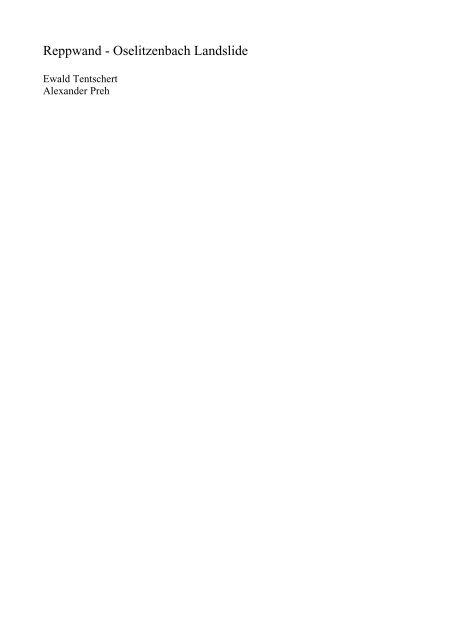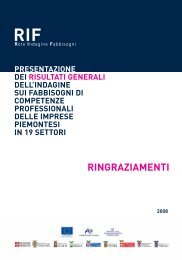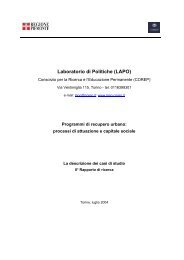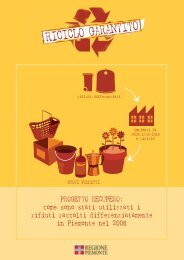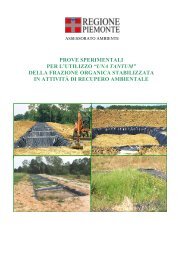Reppwand - Oselitzenbach Landslide - Extranet Regione Piemonte
Reppwand - Oselitzenbach Landslide - Extranet Regione Piemonte
Reppwand - Oselitzenbach Landslide - Extranet Regione Piemonte
Create successful ePaper yourself
Turn your PDF publications into a flip-book with our unique Google optimized e-Paper software.
<strong>Reppwand</strong> - <strong>Oselitzenbach</strong> <strong>Landslide</strong><br />
Ewald Tentschert<br />
Alexander Preh
IMIRILAND – Impact of Large <strong>Landslide</strong>s in the Mountain Environment: Identification and Mitigation of Risk<br />
<strong>Reppwand</strong> - <strong>Oselitzenbach</strong> <strong>Landslide</strong> D2-WP1<br />
1 INTRODUCTION............................................................................................................................................3<br />
2 REGIONAL FRAMEWORK ..........................................................................................................................4<br />
2.1 CLIMATE......................................................................................................................................................4<br />
2.2 REGIONAL MORPHOLOGY .............................................................................................................................4<br />
2.3 REGIONAL GEOLOGY AND STRUCTURAL SETTING..........................................................................................4<br />
3 LOCAL FRAMEWORK..................................................................................................................................6<br />
3.1 LOCAL GEOLOGY AND STRUCTURAL SETTING................................................................................................6<br />
3.2 WATER CONDITIONS.....................................................................................................................................6<br />
4 LANDSLIDE ....................................................................................................................................................7<br />
4.1 LANDSLIDE IDENTIFICATION .........................................................................................................................7<br />
4.2 LANDSLIDE DETAIL ......................................................................................................................................8<br />
4.3 LANDSLIDE MORPHOLOGY............................................................................................................................8<br />
4.4 LANDSLIDE HISTORY....................................................................................................................................8<br />
5 LANDSLIDE INVESTIGATION AND MONITORING ................................................................................9<br />
5.1 SURVEY AND MONITORING OF LANDSLIDE ACTIVITY ......................................................................................9<br />
5.2 MONITORING OF METEOROLOGICAL AND HYDRAULIC CONDITIONS ............................................................... 10<br />
6 MODELLING ................................................................................................................................................ 10<br />
7 STABILIZATION/PROTECTION WORKS AND LEGAL FRAMEWORK ............................................. 11<br />
8 LAND USE AND RISK ASSESSMENT/MANAGEMENT .......................................................................... 11<br />
8.1 LAND USE .................................................................................................................................................. 11<br />
8.2 ELEMENTS AT RISK..................................................................................................................................... 11<br />
9 FIRST SCENARIOS ...................................................................................................................................... 12<br />
10 REFERENCES.............................................................................................................................................. 12<br />
11 PICTURES .................................................................................................................................................... 12<br />
2
IMIRILAND – Impact of Large <strong>Landslide</strong>s in the Mountain Environment: Identification and Mitigation of Risk<br />
<strong>Reppwand</strong> - <strong>Oselitzenbach</strong> <strong>Landslide</strong> D2-WP1<br />
1 INTRODUCTION<br />
The area at the north slopes of the so called “Carnic Alps” in the southern part of Austria`s county<br />
of Carinthia is affected by numerous mass movements.<br />
Thus, the Naßfeld-area, dewatered by a torrent called <strong>Oselitzenbach</strong>, consists of carbonian<br />
sedimentary beds containing clayey schists, sandstones, marls and limestones.<br />
The <strong>Reppwand</strong>-<strong>Oselitzenbach</strong> sagging zone consists of interlayers of competent and incompetent<br />
rocks, which are highly deformed and disturbed by long-term sagging and gliding processes.<br />
The movements (measurements since 1983) are very inhomogeneous, reaching from some cm/y<br />
up to some areas with deformations of more than 1 m/y.<br />
The risks are in destruction of the Naßfeldroad (crossing over the Alps to Italy and touching a<br />
great ski area), as well as in possible spreadout of landslide material by the <strong>Oselitzenbach</strong> torrent<br />
(which happened partly by heavy rainfalls in 1983)<br />
Several measures have been made to stabilize the landslide (drainages, debris dams in the river,<br />
deviation of the torrent, anchoring of the road cuts and -slopes), which led to some lowering of the<br />
movements, but they are still going on with reduced amounts.<br />
Figure 1 : topographic area<br />
3
IMIRILAND – Impact of Large <strong>Landslide</strong>s in the Mountain Environment: Identification and Mitigation of Risk<br />
<strong>Reppwand</strong> - <strong>Oselitzenbach</strong> <strong>Landslide</strong> D2-WP1<br />
2 REGIONAL FRAMEWORK<br />
2.1 Climate<br />
Alpine-mountain climate (westward winds), influenced additionally by Adriatic lows.<br />
Main rainfall in summer (> 50 % of annual precipitation), but even heavy rainfalls in Oct-Nov.<br />
Annual precipitation 2963 mm/yr (one of the most intense rainfall areas of Austria, measured at a<br />
sea level of 1530 m)<br />
Average annual Temperature: +7° C, minima : Jan.: - 18°C, maxima in Summer : +30°C.<br />
Snow covering: depending on sea level: in 1000 m s.l.: Nov. – March, in 2000 m: Oct - May;<br />
Snowfall is possible all over the year.<br />
2.2 Regional Morphology<br />
The Carnic Alps, making the border between Austria (county Carinthia) and Northern Italy are a<br />
East-West striking mountain chain up to 2700 m. The main valley (Gailtal, 600 m a.s.l.) in the north<br />
is parallel to these chains, whereas the smaller tributaries cut transverse through the structures by<br />
steep and narrow valleys, mainly cut after the last Ice age.<br />
2.3 Regional Geology and Structural Setting<br />
As a part of the Carnic Alps, the stratigraphical order starts with light metamorphic rocks (lower<br />
paleozoic), overlain by intensely folded and fractured schists(mainly sandstones and marlstones of<br />
Devonian-Permian Age). These complex is partly overlain by triassic sequences.<br />
In the main valley of the Gailtal, near to the site, the continental tectonic divide of the<br />
“Periadriatic lineament” passes through (dividing the Northern from the Southern Alps from the<br />
Northern Italy to Slovenija). This leads to parallel faults to the periadriatic lineament (East-West),<br />
to some Riedel shears (diagonal) and extension joints (A-C- Joints, North-south).<br />
4
IMIRILAND – Impact of Large <strong>Landslide</strong>s in the Mountain Environment: Identification and Mitigation of Risk<br />
<strong>Reppwand</strong> - <strong>Oselitzenbach</strong> <strong>Landslide</strong> D2-WP1<br />
Figure 2: Regional Geology (SCHÖNLAUB, 1987)<br />
5
IMIRILAND – Impact of Large <strong>Landslide</strong>s in the Mountain Environment: Identification and Mitigation of Risk<br />
<strong>Reppwand</strong> - <strong>Oselitzenbach</strong> <strong>Landslide</strong> D2-WP1<br />
3 LOCAL FRAMEWORK<br />
3.1 Local Geology and structural setting<br />
The project area covers an alpine valley with elevations ranging from 590 m to 2000 m within the<br />
catchment area of the <strong>Oselitzenbach</strong>.. The “rock menu” consists mainly of:<br />
- Auernig-schists: Conglomerates, partly transgressive formed Limestone beds, partly<br />
conglomerates<br />
- Hochwipfel-schists: dark greyish sandy-siltstones, scarcely calcareous. Well bedded, with<br />
interlayers of clayey material; partly graphtolith-schists. Mainly hard, and brittle behaviour.<br />
- Rattendorfer Schists: limestones, dark, grey. Sometimes thin interlayers of siltstone.<br />
Both stratigraphically and topographical above (outside the landslide area) there are also triassic<br />
sediments (limestones, marlstones, dolomites)<br />
In the disturbed areas the Auernig- and Hochwipfel-schists cannot be precisely distinguished in<br />
the field. In this case they are summarised as the “Naßfeld-schists”.<br />
The bedding planes are mainly dipping south, against the slope and the main scarp. The main<br />
fault zones are (sub-)parallel to the Periadriatic lineament (carving the main valley of the Gail river)<br />
striking WNW. The main joints are dipping steeply to NW.<br />
3.2 Water Conditions<br />
Figure 3: Local Geology (from WEIDNER, 2000)<br />
Groundwater conditions:<br />
upper part: shallow infiltration, coming to daylight as springs in the middle part<br />
In the lower part: water losses by deep rotational slide planes.<br />
The groundwater velocities in the upper part are about 0,2-5 m/h (proved by a tracer test).<br />
There are three horizons of springs: The highest horizon of springs lies between an elevation of<br />
1150 and 1170m. In this horizon there are two lakes, the "großer Bodensee" and the "kleiner<br />
6
IMIRILAND – Impact of Large <strong>Landslide</strong>s in the Mountain Environment: Identification and Mitigation of Risk<br />
<strong>Reppwand</strong> - <strong>Oselitzenbach</strong> <strong>Landslide</strong> D2-WP1<br />
Bodensee", additionally there are springs westward of the lake "großer Bodensee" and water outlets<br />
in the waterlogging zone eastward of the lake "kleiner Bodensee".<br />
The area of the second horizon lies 20m deeper (1130-1150m), in the north of the lake "großer<br />
Bodensee".<br />
In the third horizon there are many selective water outlets below the Naßfeld road(level 700-<br />
800).<br />
The "bodensee" lakes lie in a small depression, made up by zones of movement. The greater lake<br />
is fed by 2 small tributaries and a small runoff river- the smaller lake has no tributary, but a small<br />
runoff (3-5 l/s).<br />
4 LANDSLIDE<br />
By the sagging mass of the <strong>Reppwand</strong>-landslide the valley floor of the <strong>Oselitzenbach</strong> became very<br />
narrow, the torrent eroded the toe of the mass, which increased the activity again.<br />
Above the main scarp of the mass there are outcrops of massive limestones with steep slopes.<br />
The morphology of the sagging area shows a very troubled surface with a diverse<br />
micromorphology.<br />
Within the great <strong>Reppwand</strong>-slide there are several smaller slides, especially in the lower parts.<br />
The lowest part of the <strong>Oselitzenbach</strong> is a steep inclined valley to reach the deeper situated main<br />
valley of the Gail Valley.<br />
4.1 <strong>Landslide</strong> Identification<br />
Figure 4: main scarp of the <strong>Reppwand</strong>-slide<br />
The main scarp shows lower permian limestones (Trogkofelkalk) and Gröden sandstones and<br />
Bellerophon-schists (middle-upper Permian). The scarp is reaching from level 1700-1300, has an<br />
angle of 40° - the lower partial landslide mass reaches from level 1300-900, with an angle 15-17°.<br />
The covered area is about 3 Mio m², the estimated volume is 150 Mio. m³.<br />
Within diverse homogeneous regions, there are different homogeneous regions, having different<br />
displacement rates. Since the measures were finishes in 1991, the displacement rates diminished.<br />
Homogeneous region 1988-1991 1991-2000<br />
“Seebach” above road 0,9 cm/month 0,5 cm/month<br />
“Quellenbach” 1,3 cm/month 0,65 cm/month<br />
Roadmaster hut 0,4 cm/month 0,35 cm/month<br />
7
IMIRILAND – Impact of Large <strong>Landslide</strong>s in the Mountain Environment: Identification and Mitigation of Risk<br />
<strong>Reppwand</strong> - <strong>Oselitzenbach</strong> <strong>Landslide</strong> D2-WP1<br />
4.2 <strong>Landslide</strong> Detail<br />
The main difference between the (faster) lower part to the upper part is in the clay content, which is<br />
higher in the lower part. The intensity or disaggregation is higher here, too.<br />
The lower part, being the most active slide area, has a difference level of 165 m (from s.l. 1015-<br />
850m) and a depth of ca. 50 m. The travel angle is about 19°.<br />
4.3 <strong>Landslide</strong> Morphology<br />
Figure 5: main scarps, landslide boundary’s and retaining structures (from MOSER et al., 1988)<br />
4.4 <strong>Landslide</strong> History<br />
September 1983: Flooding in September 1983 led to massive gravel deposits at the alluvial cone of<br />
the <strong>Oselitzenbach</strong>, a cutoff of the Naßfeld road, and the destruction of old torrent control dams<br />
along the upper and middle course of the torrent "Rudingbach".<br />
1985: Planning of an extensive construction programme carried out by the Austrian Service for<br />
Torrent, Erosion and Avalanche Control as a reaction to the events in September 1983.<br />
8
IMIRILAND – Impact of Large <strong>Landslide</strong>s in the Mountain Environment: Identification and Mitigation of Risk<br />
<strong>Reppwand</strong> - <strong>Oselitzenbach</strong> <strong>Landslide</strong> D2-WP1<br />
August 1987: As a consequence to repeated flooding and the resulting advancing undercutting of<br />
the eastern toe of the landslide there was a run out of 60.000m³ in volume and resulting intense<br />
settlements up to some metres and formation of new cracks up to 30 m above the Naßfeld road.<br />
1988: Realisation of the extensive construction programme. As a part of the construction<br />
measures a 400 m long channel was excavated in massive Hochwipfel formations as well as a<br />
filling up at the toe was made of the excavated material (about 170.000m³). Additional measures<br />
were:<br />
- Drainage of the Quellenbach landslide between level 830-920 m and<br />
- The draining off of the water, also above a level from 950m to the area of the Bodensee-lake.<br />
Figure 6: on the left hand side : <strong>Reppwand</strong>-slide, in the middle: deviated river channel, foreground: Naßfeld road<br />
Comparing the average values there has been a significant stabilisation after the finalisation of<br />
the construction measures in most areas. Periods A (1988 - 1991, before the construction measures)<br />
and B (1991 - 2000, after the construction measures) have therefore been compared showing the<br />
following:<br />
- Areas of low velocity (< 5 cm/y) have significantly increased in period B, whereas zones of high<br />
velocity (>10cm/y) have decreased.<br />
- Above the filling up an extensive stabilisation has been recorded in period B.<br />
- The most active zone in both periods is the upper area of the Quellenbach-slide, which however<br />
shows a stabilisation as well in period B from 10-15cm/y down to 7-15 cm/y.<br />
- Relatively high movements can still be observed east of the point RP below the Naßfeld road.<br />
5 LANDSLIDE INVESTIGATION AND MONITORING<br />
5.1 Survey and monitoring of landslide activity<br />
8 boreholes, up to 52 m depth.<br />
One equipped with inclinometer<br />
Refraction seismics, 2 profiles:<br />
three seismic layers: upper layer: 450-1200 m/s (disturbed rock) , thickness ca. 10 m<br />
layer 2: v=1500-2000 m/s, weathered and jointed rock, thickness 10-50 m<br />
layer 3: v= 3000-4000 m/s, jointed dock<br />
9
IMIRILAND – Impact of Large <strong>Landslide</strong>s in the Mountain Environment: Identification and Mitigation of Risk<br />
<strong>Reppwand</strong> - <strong>Oselitzenbach</strong> <strong>Landslide</strong> D2-WP1<br />
Geotechnical Testing of the material (disturbes “Naßfeld-schists”, mainly clayey.<br />
friction angle: 18°, cohesion = 14 kM /m²<br />
Wn: 10,6 % (semi-stiff) to 34,3% (slurry)<br />
WL: 22,5-26,4 %<br />
Monitoring:<br />
60 geodetic points, partly measured since 1985,<br />
1 Inclinometer-probe type<br />
1 wire extensometer, l = 45 m, digital monitoring, measures every 2 min.<br />
9 convergence scanlines (fixed endpoints), measurement with steel tape (Fa. Soil instruments MK<br />
II) , accuracy 1/100 mm.<br />
5.2 Monitoring of meteorological and hydraulic conditions<br />
There are two meteorological stations:<br />
1 station in the valley<br />
1 station in the ski-area above the site (s.l. 1530) - both with daily Temperature and rain<br />
measurements.<br />
6 MODELLING<br />
The numerical investigations will be realised with FLAC3D and PFC2D of the Itasca Consulting<br />
Group. FLAC3D is used for modelling the continuum mechanics behaviour of the investigated area.<br />
PFC2D will be used for modelling the failure mechanism and the run out.<br />
FLAC3D:<br />
The FLAC3D-Model is based on the digital surface model of the BEV(Bundesamt für Eich- und<br />
Vermessungswesen) and the refraction seismic section. The seismic investigations gave a three<br />
layer structure which is implemented in the FLAC-Model.<br />
Figure 7: refraction seismic section (from WEIDNER, 2000)<br />
PFC2D:<br />
The location of the longitudinal section for the PFC analyses is based on the investigations by<br />
FLAC and the results of the geodetic observations.<br />
10
IMIRILAND – Impact of Large <strong>Landslide</strong>s in the Mountain Environment: Identification and Mitigation of Risk<br />
<strong>Reppwand</strong> - <strong>Oselitzenbach</strong> <strong>Landslide</strong> D2-WP1<br />
7 STABILIZATION/PROTECTION WORKS AND LEGAL FRAMEWORK<br />
Deviation of river:<br />
As a consequence to repeated flooding and the resulting advancing undercutting of the eastern<br />
toe of the landslide the <strong>Oselitzenbach</strong> torrent got a new riverbed. Some meters to the north, the<br />
400m long new bed was cut into the massive Hochwipfel formations under the left banks, those<br />
preventing the erosion at the sagging toe. A filling up at the toe was made of the excavated material.<br />
Barriers:<br />
Torrent barriers in the river to lower the inclination lines of the riverbed, thus reduce erosion<br />
processes.<br />
Figure 8: debris barriers and river channel<br />
Drainages:<br />
The Drainage of the Quellenbach landslide between level 830-920m and also the draining off of<br />
the water above a level from 950m to the area of the "Bodensee"-lake.<br />
8 LAND USE AND RISK ASSESSMENT/MANAGEMENT<br />
8.1 Land Use<br />
In the landslide area: wood, but downstream even fields, meadows, gardens.<br />
Some 200 inhabitants in the two villages downstream of the landslide area. Farmhouses and<br />
agricultural land.<br />
Intensely frequented road to ski areas and crossover to Italy<br />
8.2 Elements at Risk<br />
Spread out of landslide material by the torrent down to the villages, breakdown of the road,<br />
destruction of road, skilifts.<br />
Since the deviation of the torrent near the toe of the sagging zone was done, the movements<br />
could be reduced to 3 cm/y. The risk doesn’t exist in the slope itself but especially in the<br />
11
IMIRILAND – Impact of Large <strong>Landslide</strong>s in the Mountain Environment: Identification and Mitigation of Risk<br />
<strong>Reppwand</strong> - <strong>Oselitzenbach</strong> <strong>Landslide</strong> D2-WP1<br />
downstream valley section. In the years 1983 and 1987, after heavy rainfalls, the toe of the mass<br />
movements was eroded with deposition of 300.000 m³ and 50.000 m³, respectively.<br />
Nevertheless, even by the reduced movements the downstream villages of Tröpolach and<br />
Watschig in the main valley could be affected. Further the collapse of the slope could endanger the<br />
main road, the Naßfeld - Bundesstraße, which is a very important connection to another valley, the<br />
“Gailtal”.<br />
9 FIRST SCENARIOS<br />
The first estimations for scenarios have been made without special investigations: without erosion<br />
of the toe the maximal spreadout of material could be ca. 150.000 m³.<br />
In the case of erosion and undercutting by the torrent , max. 300.000 m³ could be activated.<br />
In the model calculations special attention will be paid on the shear parameters of the “Naßfeldschists”,<br />
which are very sensitive in terms of water content.<br />
The aim of the model calculations is to achieve concise runout models for different scenarios.<br />
10 REFERENCES<br />
GAMSJÄGER, L.: Geologisch-geotechnische Aufnahmen der Großhangbewegung Naßfeld, Gailtal/Kärnten. PhD thesis<br />
Uni Innsbruck (unpublished).<br />
GLAWE, U.: Geologisch-geotechnische Untersuchungen an der Schlanitzenalmgleitung und der Bergzerreißung<br />
Treßdorfer Höhe (Karnische Alpen, Kärnten). Master thesis Uni Erlangen-Nürnberg unpublished.<br />
GLAWE, U.; LOTTER, M.: Rock slope behaviour prior to failure at the Treßdorfer Höhe, Austria. In: <strong>Landslide</strong> news, Jg.<br />
1997, H. 10, S. 11-14.<br />
GLAWE, U.; MOSER, M.: Erste untersuchungsergebnisse zur Kinematik der Bergzerreissung Treßdorfer Höhe<br />
(Karnische Alpen). In: Jb. GBA, 132. Jg. (1989), H. 4, S. 629-644.<br />
HÖTZL, H.; MOSER, M.; REICHERT, B.; RENTSCHLER, K.: Hydrologische Markierungsversuche in Massenbewegungen.<br />
<strong>Reppwand</strong>gleitung, Kärnten und Stubnerkogel, Salzburg. In: Steir. Beiträge z. Hydrogeologie, Jg. 1994, H. 45, S.<br />
69-92.<br />
KAHLER, F.; PREY, S.: Erläuterungen zur geologischen Karte des Naßfeld-Gartnerkofel-Gebietes in den Karnischen<br />
Alpen. Wien (GBA) 1963. (+ Erl. geol. Karten)<br />
KRONFELLNER-KRAUS, G.: Beiträge zur Wildbacherosions- und Lawinenforschung. In: Ber. FBVA, Jg. 1990, H. 43, S.<br />
7-24.<br />
LOTTER, M.: Geotechnische und kinematische Untersuchungen an instabilen Felshängen im alpinen Raum. PhD thesis.<br />
Uni Erlangen-Nürnberg unpublished<br />
LOTTER, M.; MOSER, M.; GLAWE, U.; ZVELEBIL, J.: Parameters and kinematic processes of spreading of mountain<br />
ridges. Aus: Moore, D; Hungr, O. (Hrsg.): Proc. 8th IAEG Congress Vancouver (Balkema, Rotterdam) 1998. S.<br />
1251-1257.<br />
MOSER, M.: Geologisch-Geotechnischer Bericht für 2000. Unter bes. Berücks. der Bewegungsmessungen (Per. 14-15,<br />
Juni 1999- Okt. 2000) Erlangen 2001.<br />
MOSER, M.; ANGERER, J.; SEITZ, S.: Geotechnische Untersuchungsergebnisse im Rahmen des Verbauungsprojektes<br />
<strong>Oselitzenbach</strong>/Kärnten. In: Interprävent (Ed): Interprävent3, Graz 1988. S. 77-102.<br />
MOSER, M.; GLAWE, U.: Das Naßfeld in Kärnten - geotechnisch betrachtet. In: Abh. Geol. BA, Jg. 1994, H. 50, S. 319-<br />
340.<br />
MOSER, M.; WINDISCHMANN, TH.: Die <strong>Reppwand</strong>gleitung/Kärnten. Geologische und geotechnische Betrachtungen. In:<br />
Oberrhein. geol. Abh., 35. Jg. (1989), S. 157-176.<br />
SCHÖNLAUB, H.P.: Geologische Karte der Republik Österreich 1:50000, Blatt 198 (Weißbriach). Geol.BA. Wien 1987<br />
WEIDNER, S.: Kinematik und Mechanismus alpiner Hangdeformationen unter bes. Berücksichtigung der<br />
hydrogeologischen Verhältnisse. PhD Thesis.Uni Erlangen, 2000, unpublished<br />
11 PICTURES<br />
Figure 1 : topographic area ..........................................................................................................................................3<br />
Figure 2: Regional Geology (SCHÖNLAUB, 1987) .........................................................................................................5<br />
Figure 3: Local Geology (from WEIDNER, 2000) ..........................................................................................................6<br />
Figure 4: main scarp of the <strong>Reppwand</strong>-slide.................................................................................................................7<br />
Figure 5: main scarps, landslide boundary’s and retaining structures (from MOSER et al, 1988).....................................8<br />
Figure 6: on the left hand side : <strong>Reppwand</strong>-slide, in the middle: deviated river channel, foreground: Naßfeld road ........9<br />
Figure 7: refraction seismic section (from WEIDNER, 2000)........................................................................................ 10<br />
Figure 8: debris barriers and river channel.................................................................................................................. 11<br />
12


